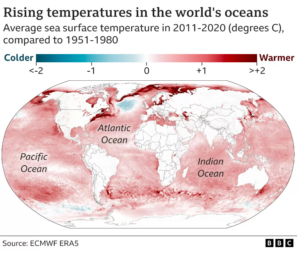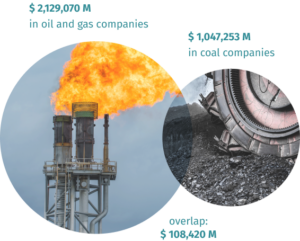“Endless record heat” over Asia. Strange Spring heat waves from Spain to Botswanna. Is it because the ocean has never been hotter? Then Katrin Gandswindt from Urgewald names the trillion dollar pension funds and investment houses paying for a new surge in fossil fuel production. Psychologist Derrick Sebree Jr. on the African American experience during the climate shift.
We cover the world. This is Radio Ecoshock.
Listen to or download this Radio Ecoshock show in CD Quality (57 MB) or Lo-Fi (14 MB)
=====================
My thanks to the listener in New Zealand whose donation keep Radio Ecoshock funded and going into June. You really, really helped. Other listeners contribute as they can, and some at $10 a month which is super for paying bills. It costs money to make a radio show from all stages from research through phone costs to distribution. Several gigabytes a day of climate audio is downloaded from our station web site – another ongoing cost. If you can help support listener-supported science journalism, keeping it free for all and advertising free – please do! This page gives a couple of options…
======================
EXTREME ASIAN HEAT COOKS OVER A BILLION HUMANS
Over a billion people sweltered through an April heat wave that broke record after record across Asia. Extreme heat was cooking in Pakistan and deadly in India, where 12 people at an outdoor rally died in the heat. Almost half of India’s population works outdoors, and must work to eat. Damage to crops there is still being assessed. Extreme heat combined with big city air pollution in both India and Thailand to make a deadly brew. So far in 2023, over a million Thai people sought medical treatment for breathing problems in the smog. Schools have been closed in several countries.
By the way, I put links to my sources for all this news, along with a bunch of YouTube news videos, at the bottom of this blog. You can follow up and learn more about this unique event on planet Earth. (Although it will be surpassed soon…)
The heat block spread to Southeast Asia with more record extremes. According to Rebecca Ratcliffe in the Guardian April 27, new heat records were set across “across Thailand, Myanmar, Laos and Vietnam, as well as in China and South Asia.” Health authorities in Thailand advised citizens to stay home. Temperature in Bangkok reached 42 degrees C (107 F) – but combined with high humidity this felt like 54 degrees C. That is 129 degrees Fahrenheit.
According to climatologist and weather historian Maximiliano Herrera, Laos hit the highest reliable temperature in it’s history last week. Experts are calling this “the worst heat wave in Asian history”, and it has been cooking the region for weeks. The future has arrived.
Other extreme hotspots have popped up all over the planet in recent weeks. You probably heard about Sahara-like heat washing over Spain last week. It was over 16 degrees – about 29 degrees Fahrenheit, hotter than previous years, unprecedented in Spain. In the Southern African country of Botswana, they recorded the hottest April day ever recorded. It should be the start of the colder season there, not 40 degrees C, or 104 degrees Fahrenheit in the shade.
All this excess heat is coming during a La Nina year, which is supposed to be cooler, and before an expected change to the El Nino event next winter, which will make it even hotter.
We know the ultimate cause of all this: humans have changed the atmosphere with fossil fuel emissions, and by damaging the natural carbon cycle. But are hotter oceans also driving recent heat on land?
HOTTER OCEANS!!
The BBC Climate and Science team just published an alarming story about recent rapid ocean warming. I found it very upsetting. BBC authors Matt McGrath and Mark Poynting say: “Several scientists contacted for this story were reluctant to go on the record about the implications. One spoke of being ’extremely worried and completely stressed.’”
When your scientists freak out, it is time to pay attention.
The article contains a map from ECMWF, the European Centre for Medium-Range Weather Forecasts. It shows average sea surface temperatures in 2011-2020 compared to 1951 to 1980. The world’s oceans appear to have developed a fever. The worst is around the far north, but seas along the coasts of Alaska, New England, Kamchatka, and China are sizzling too, up to 2 degrees C warmer than in previous decades. That doesn’t sound like much, but indicates vast amounts of energy added to the oceans.

But now in the news, even hotter marine heat waves are laid over that map of longer term averages. The North Pacific and the North Atlantic have a marine fever. According to a new study by Karina von Schuckmann and 67 co-authors, quoting the BBC here: “Over the past 15 years, the Earth has accumulated almost as much heat as it did in the previous 45 years, with most of the extra energy going into the oceans.”
In decades of measuring temperatures, world oceans have never been hotter than in April 2023. Think about that. A new global record ocean heat.
As I mentioned, there worse hotspots laid on top of that. The BBC article says: “In March, sea surface temperatures off the east coast of North America were as much as 13.8C higher than the 1981-2011 average.” Maine lobster fishers know, and they are worried.
To be clear, the record sea temps set in March and April do not come from the Von Shuckmann paper. A number of media outlets quote figures from the open access real-time services like climatereanalyzer.org and earthnullschool.net. For example, Sam Carana at the Arctic News blog uses Nullschool to find “Sea surface temperatures off the east coast of North America s much as 13.8 degrees C or 24.8 F higher than 1981-2011” That was for the date March 15.
One caution: while a flare-up has occurred, care is needed when picking a certain place in the world on one day or during one month. We do not know the total influences, beyond global heating, that created this anomaly. Von Shuckmann’s paper notes the unknowns. It is happening, but the mechanisms and proofs still have uncertainty.
I have been covering the ocean heat story for years. In the last three years, top scientist Kevin Trenberth has appeared a half dozen times to explain the extent and risks of making the ocean hotter. The risks are so huge we can barely comprehend them. They include more sea level rise, faster polar ice melt, mass deaths of marine species including corals, harsher hurricanes, and the approaching state where the sea takes up less of our carbon dioxide pollution. If that ocean carbon capture facility drops even a little, ALL of the carbon we burn into the sky will heat us pretty directly. We lose the ocean protective buffer.
VOA, Voice of America did some good reporting on this, based on Associated Press. Quoting their April 17 article “Sudden Ocean Warming Spike Stirs Concern”:
“”This is an unusual pattern. This is an extreme event at a global scale” in areas that don’t fit with merely an El Nino, said Princeton University climate scientist Gabe Vecchi. “That is a huge, huge signal. I think it’s going to take some level of effort to understand it.”
The University of Colorado’s Karnauskas took global sea surface temperature anomalies over the past several weeks and subtracted the average temperature anomalies from earlier in the year to see where the sudden burst of warming is highest. He found a long stretch across the equator from South America to Africa, including both the Pacific and Indian oceans, responsible for much of the global temperature spike.
That area warmed four-tenths of a degree Celsius in just 10 to 14 days, which is highly unusual, Karnauskas said… Since that last El Nino, the global heat ocean content has increased .04 degree Celsius (.07 degree Fahrenheit), which may not sound like a lot but “it’s actually a tremendous amount of energy,” [another expert] Purkey said. It’s about 30 to 40 zettajoules of heat, which is the energy equivalent of hundreds of millions of atomic bombs the size that leveled Hiroshima.”
SHOULD WE PANIC ABOUT EL NINO ON TOP OF CURRENT HEAT WAVES?
This fast developing situation in sea heat is well known to science. Almost every month another major study comes from institutes all over the world working hard on this threat. Not everyone thinks this is a big strike. For example, Professor Michael Mann from University of Pennsylvania says this is expected, as a developing El Nino adds to the steady drumbeat of emissions from our stacks and tailpipes. I’m not sure we should panic about a particular heat wave. Let’s panic about the whole trend.
On the other hand, there is a growing chorus of scientists who worry Earth’s temperature will not ramp up, so many tenths of a degrees per decade, but could jump up in steps, and stay there. It is still too early to say with certainty whether this will be a strong El Nino year. The signs are there, but Spring is a notoriously bad time to predict even next winter. After three years of La Nina, some kind of El Nino seems likely. Even if that develops in the Fall of 2023, there is a lag time – meaning 2024 could be the hottest year you have ever lived. These La Nina/El Nino systems, called “ENSO” – they come and go. But Dr. Trenberth told us in an interview last September: human forced warming has overwhelmed that ocean heat cycle. Global warming is now stronger than ENSO.
You know the rest. Whether we take this planet to the burning level, too hot for mammals and most of our living friends, depends on us. If we go on looking for normal, exploring and pumping more fossil fuels, mass extinction will happen. We could choose survival instead.
Our next guest Katrin Ganswindt will tell you who is paying to pump up the heat. Then Derrick Sebree Jr. gives us the African American experience.
=============================
KATRIN GANSWINDT –
THE INVESTORS WHO FUND FUTURE DESTRUCTION
Last week we revealed terrible news. Big banks are financing a new surge of climate-killing fossil fuels. But the banks are dwarfed by institutional investors, including your pension funds, university endowments, insurance giants and more. We are talking about trillions of dollars poured into more oil, gas, and coal.
It is midnight for climate change. Do you know where your money is?
You can find out, thanks to a new free online database created by a coalition of Non-Profits. We can find out where financial power really lives. Our guide is Katrin Ganswindt, Head of Finance Research for the famous German environment group Urgewald. We are in good hands.

From Germany, we welcome Katrin Ganswindt back to Radio Ecoshock.
Listen to or download this 23 minute interview with Katrin Ganswindt in CD Quality or Lo-Fi
EVEN THE PRESS RELEASE SHOULD CURL YOUR HAIR…
“Over 6,500 institutional investors are holding bonds and shares in coal, oil and gas companies worth a total of US$ 3.07 trillion.”
When we talked last November, Katrin warned oil, gas, and coal companies have announced enough expansion to break the future. There is a surge in fossil fuel expansion right at the time we need to slash emissions or lose a good place to live. It is very discouraging. In the last few days, for example, Norway announced they will change policy and encourage Arctic drilling. They say more fossil fuels are needed to power Europe.
Actually, Europeans need to drastically slash fossil burning. The recent heat wave in Spain and Portugal – in April – is just the beginning. In 2022, the famous Alps mountain chain lost 6% of it’s glacier mass – on one year. And as you heard, India and southeast Asia can’t take much more heat before mass climate migration sends hundreds of millions of people north.
WHO IS FUNDING THE CRAZY FOSSIL FUEL EXPANSION?
A key question becomes: who is providing countless billions of dollars to expand oil and gas, from the Arctic to the Amazon? And who is in control? We begin with the Terrible Two: American investment companies Vanguard and BlackRock provided over half a trillion dollars to the fossil fuel industry. They alone could help change the course of climate change. Add in another dozen giant American investment banks, and they could save a livable climate.
Vanguard makes no pretense of caring about the future climate. That isn’t going to stop their trillions in investments in fossil fuels. BlackRock did join a consortium of companies promising to head toward Net Zero. That was just last Fall, and already they are breaking those promises.
From the new report press release:
“’If it is bad for the environment, it is bad for retirement. Vanguard’s retirement schemes are built on investments that jeopardize our future,’ comments Doug Norlen from Friends of the Earth US, a partner of the Vanguard-SOS campaign.”
Out of the 200 coal, oil and gas companies in which Vanguard holds shares and bonds, its biggest single investment (US$ 34 billion) is in ExxonMobil, a company that has done more than any other to obstruct the adoption of effective climate policies. ExxonMobil is also one of the most aggressive oil and gas developers: it is currently exploring or developing new oil and gas fields in 40 countries.
Vanguard’s CEO, Tim Buckley, has made abundantly clear that he has no intention of putting restrictions on investments in climate-destructive business models. Consequently, Vanguard dropped out of the Net Zero Asset Managers Initiative in December 2022.”
THE MEN IN CONTROL
The investigation by this consortium of concerned environment NGOs found 23 big institutional investors provided about half of all investments by fossil fuel companies. We think climate will be decided by politicians, but really the CEO’s and stock-holders of just 23 companies are in control of our future. Should we all know who they are?
A few years ago, Greenpeace Germany put up billboards with faces of executives they called “climate criminals”. Maybe it is time for some new billboards and social media campaigns to put faces on climate killing for profit. Does that sound too extreme? Not as extreme as climate change.
Americans with a retirement savings plan through their employers are strongly encouraged to create a 401(k) plan. They must agree to have a percentage of each paycheck paid directly into an investment account. In this way, working people are made into investors by government design. Where does that money go, who controls it, and are ordinary workers funding climate destruction?
This new “Investing in Climate Chaos 2023” report found US investors account for 64% of institutional investments in fossil fuel companies included in this massive study of thousands of companies. It appears America alone could save the world climate from outright disaster – if American controlled investment companies agree and act responsibly. But the U.S. government has been back and forth on the Paris Climate Accord, as weak as that was. With the government and the populace split, do you see hope that Americans will choose to save remnants of a climate worth living in?

EUROPEAN BAD ACTORS
Then we have the big financial hub in London, dubbed “The City”. They are the second largest funder of dangerous fossil fuels. You get some hard data from the report press release:
“The largest UK investor in fossil fuels is the insurer Legal & General with investments of US$ 14 billion. Second in the European country ranking is Norway (US$ 59.6 billion), thanks to its Government Pension Fund, whose fossil investments of US$ 40.9 billion make it Europe’s single largest institutional investor in fossil fuels.
Next in the European country ranking is Switzerland (US$ 48 billion), whose largest fossil investor UBS already held fossil shares and bonds worth US$ 20.8 billion before it took over Crédit Suisse. Fourth in line is France (US$ 46.6 billion), where Crédit Agricole with its asset manager Amundi holds fossil shares and bonds in value of US$ 21.5 billion. Germany (US$ 45.9 billion) holds 5th place in Europe. Its largest fossil investor is Deutsche Bank with its asset manager DWS, which holds US$ 17.7 billion in coal, oil and gas companies.”
Get access to all this overview of fossil financing, with helpful graphs and all the names, at https://investinginclimatechaos.org/ . The website is a joint project of Urgewald and more than 20 NGO partners. It provides a detailed breakdown of each investor’s holdings in upstream oil and gas producers and companies operating along the thermal coal value chain.
“The 5 non-US institutions among the world’s top 23 fossil investors are the Life Insurance Corporation of India and the public pension and investment funds of Japan, South Korea, Norway and Saudi Arabia. All of these are public entities, with a long-term mandate to secure the prosperity of their nation’s citizens. “
Be sure to check whether your bank or investment company is funding even more climate change. Move your money if you can. Some credit unions are cleaner. We can all be climate activists with our pensions, insurance companies and savings account. Wrecking the future is never a good investment.
===============================
DERRICK SEBREE JR. – CLIMATE AS “SHADOW SLAVERY”
During extreme heat in New York City, Black Americans die at twice the rate of whites. That is just the tip of climate injustice in the United States, and climate is just part of pollution hitting African Americans. As climate change ramps up the heat, storms, and floods, it puts a spotlight on systemic racism in America. Can it change?
Psychologist Dr. Derrick Sebree Jr. can trace his family roots back to slavery. Now this clinical psychologist is examining the ways abuse of nature has become a vehicle for continuing oppression. Derrick is a Core Faculty member at Michigan School of Psychology. He also practices ecopsychology.

Listen to or download this 20 minute interview with Derrick Sebree Jr. in CD Quality or Lo-Fi
As a privileged white guy in Canada, I feel highly unqualified to talk about Nature and the black experience. That is why Derrick is so refreshing in this interview. He warns the environment and nature are still being used as a “vehicle” for oppression of black people. He calls it “shadow slavery”.
Some misinformed whites think people with African appearance can withstand the heat better. But we learn from studies African Americans are more likely to die during extreme heat waves. This is partly due to racism and failure in the health care system, predisposing more to pass away during heat waves. It is also economic: African Americans are statistically more likely to live in neighborhoods with less greenery. Temperatures are even hotter where many live – the urban heat island effect.
The average life expectancy for American dropped almost four years since 2020. This was due to two pandemics: COVID-19 and thousands of opioid deaths as fentanyl arrived. Life expectancy for white people dropped to 76.1 years, but dig a little deeper. It crashed to only 70.8 years for black people. Is that not a crisis too? And that is all BEFORE we lay on even more dangerous storms, floods, and heat, heat, heat.
You can learn more from Derrick in this YouTube video.
===============
That’s it for Radio Ecoshock this week. Thank you for listening, and for your support to keep on going with hot news in a troubled world.
================
AUDIO CLIP CREDITS DURING THIS PROGRAM
Short news clips are used in this Radio Ecoshock show. You can follow up with these links.
Heatwaves ravage Asia, climate protesters disrupt Berlin | DW News
——————-
Heatwaves in Asia more frequent and intense due to climate change: Expert – CNA
———————–
Calls for more climate policy action as Asia hit by April heatwave | The World
ABC News (Australia)
————–
Asia heatwave pushing temperatures to record levels
Al Jazeera English April 19, 2023
——————-
‘Like none before:’ Deadly, record-smashing heat wave scorches Asia
by Doyle Rice.
————–
Air pollution, torrid heat hit Thailand | WION Climate Tracker
—————
‘Endless record heat’ in Asia as highest April temperatures recorded
Record figures for month recorded in Thailand, Myanmar, Laos, Vietnam, China and South Asia – Rebecca Ratcliffe in Bangkok Thu 27 Apr 2023.
—————
A FEW RADIO ECOSHOCK SHOWS ON OCEAN HEATING
Hot Oceans & Escaping Consumerism – Trenberth & Harris
Posted on January 26, 2022
The oceans just keep getting hotter, even during this La Nina year, despite the pandemic. Dr. Kevin Trenberth, Distinguished Scholar at the U.S. National Center for Atmospheric Research.
We talk about Kevin’s new paper published January 11, 2022 titled: “Another Record: Ocean Warming Continues through 2021 despite La Niña Conditions.” There are 23 authors, led by Lijing Cheng. The paper is Open Access, available free for you.
Read an authoritative introductory article about the new ocean heat study here in the Conversation.
Weather Madness Posted on September 7, 2022, top scientist Kevin Trenberth explains La Nina….
When the Weird Becomes Harder
Posted on September 30, 2020,
NCAR Distinguished Scholar Kevin Trenberth
Each year sets net record for ocean heat (2016 was an exception, not as high as 2015 or 2017 due to a major El Nino in 2016 releasing heat from sea) …
7. but that extra release of heat from the sea meant 2016 was warmest year on record in terms of global mean surface temp
Marine heat waves are increasing in different parts of world – and see “Increase in the rate of ocean warming” led by J.P. Abraham with Trenberth, which led to this article in Rolling Stone.